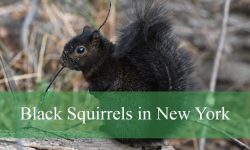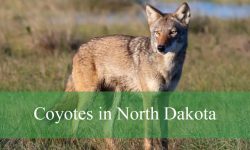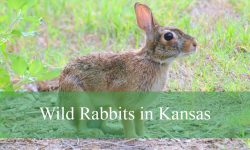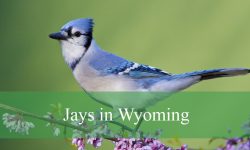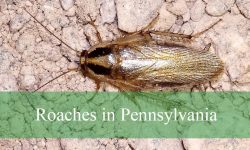Iowa is home to many colorful birds, and some of the most eye-catching are the yellow birds in Iowa. Their bright feathers and cheerful songs make them easy to spot in gardens, parks, and open fields across the state. These birds are especially active in spring and summer, adding color and life to the landscape.
There are several types of yellow birds in Iowa, from tiny warblers hiding in shrubs to bold finches at backyard feeders. Each one has its own look, sound, and behavior. Knowing where to find them and how to tell them apart can make birdwatching more fun and interesting.
This guide will help you identify 6 stunning yellow birds in Iowa, with simple tips and clear pictures. Whether you’re near a marsh, a prairie, or just your backyard, you’ll have a better chance of spotting these beautiful birds.
Common Yellow Birds Found in Iowa
American Goldfinch
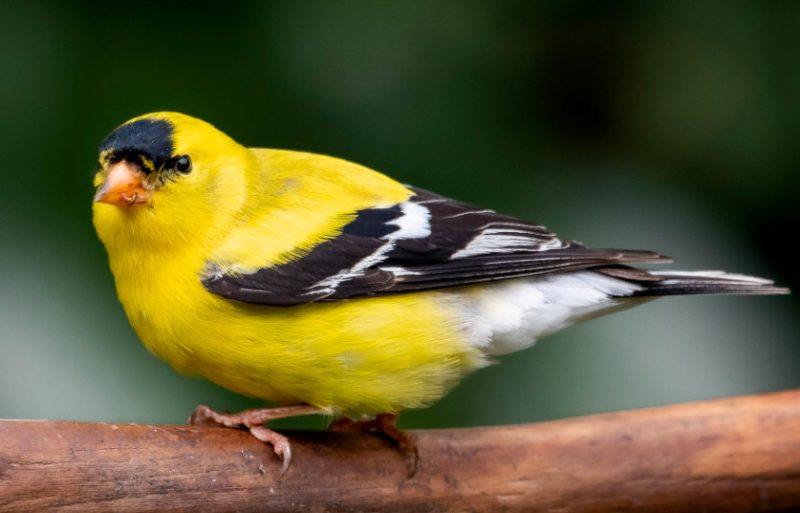
The American Goldfinch (Spinus tristis) is one of the most recognizable yellow birds in Iowa and is, in fact, the official state bird. Male goldfinches are especially striking in the summer with their vibrant lemon-yellow plumage, contrasted by a black cap on their forehead and black wings with white markings. Females are more subdued, with olive-yellow bodies and duller wings. In the winter, both sexes molt into a more muted brownish color, which can make them harder to identify. This seasonal variation in plumage is an adaptation to help them blend in better with their surroundings during colder months.
These birds are small, typically measuring around 4.5 to 5 inches in length, with a wingspan of about 8 inches. They have a short, conical beak that is perfect for seed eating. One of the American Goldfinch’s unique traits is its flight pattern, which is an undulating, wave-like motion accompanied by a musical call often described as “po-ta-to-chip.” This melodic call, along with their golden appearance, makes them a favorite among backyard birdwatchers.
Goldfinches are found throughout Iowa in open habitats such as weedy fields, meadows, roadsides, orchards, and suburban gardens. They are especially drawn to areas with native wildflowers like thistle and sunflowers, as their diet is almost exclusively seed-based. During the breeding season, which is later than most birds—often mid to late summer—they build tightly woven nests in shrubs and trees, often near open fields.
They are frequent visitors at bird feeders, especially those stocked with black oil sunflower seeds or nyjer (thistle seed). Their social and active behavior, along with their distinctive coloring and calls, make them one of the most beloved backyard birds across Iowa throughout the year.
Yellow Warbler
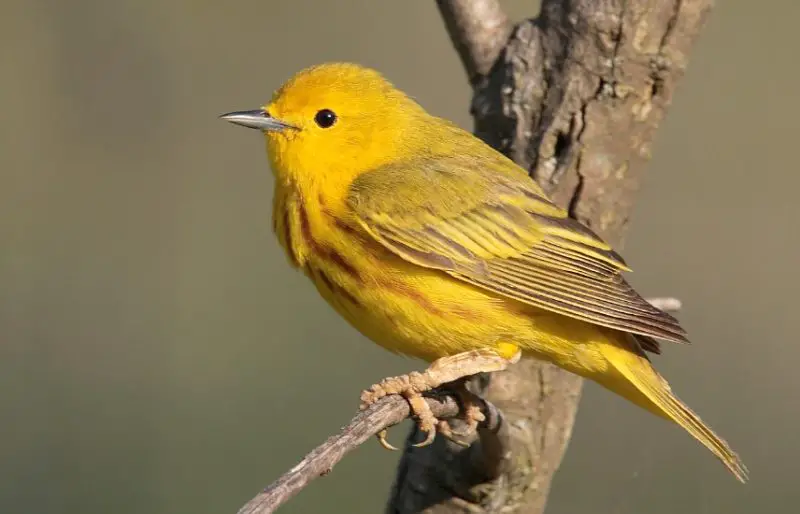
The Yellow Warbler (Setophaga petechia) is another stunning yellow bird often seen across Iowa, particularly during the spring and summer months when it migrates north to breed. Adult males are a vibrant yellow all over with reddish streaks running down their chest, while females and immature birds tend to be a bit duller with fewer markings. These birds are small and agile, typically measuring around 4.7 to 5.1 inches in length with a wingspan of about 6.3 to 7.9 inches.
Their soft “sweet-sweet-sweet-I’m-so-sweet” song is a helpful clue to their presence in dense shrubby habitats. Yellow Warblers are insectivores and are known for their energetic foraging behavior, flitting from branch to branch and often hovering briefly to snatch insects from leaves. Their diet consists primarily of caterpillars, beetles, midges, and other small arthropods.
In Iowa, Yellow Warblers breed in open woodlands, shrubby fields, and especially near water bodies like streams and wetlands where willow and dogwood thickets are abundant. They are commonly spotted during their spring migration, beginning in late April, and remain in the state through the summer months to raise their young.
Yellow Warblers build cup-shaped nests in the forks of shrubs or small trees, often low to the ground but well hidden in dense foliage. Due to their preference for wetter, shrubby environments, they are frequently seen in riparian zones and conservation areas across Iowa’s countryside.
Common Yellowthroat
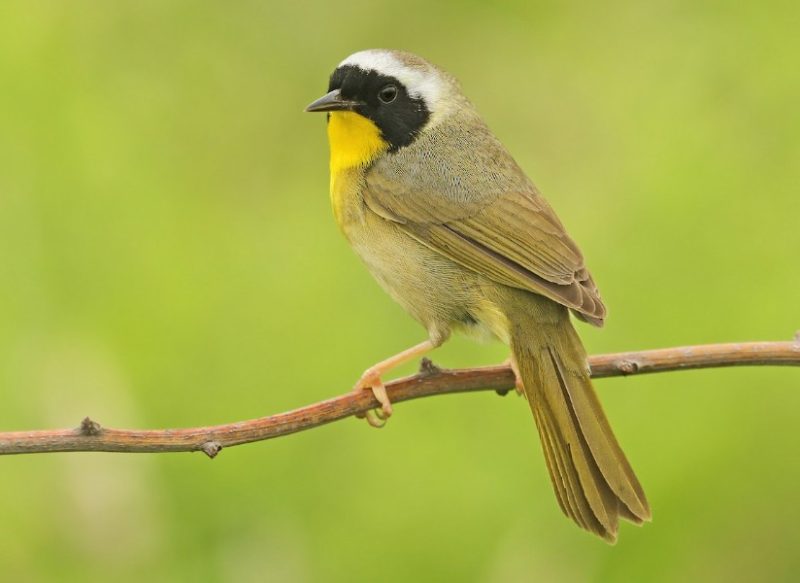
The Common Yellowthroat (Geothlypis trichas) is a small, ground-dwelling warbler that is widespread throughout Iowa during the breeding season. Males are easily identified by their brilliant yellow throat and breast, olive back, and distinctive black facial mask that extends across the eyes like a bandit’s mask. Females lack the black mask and are overall more muted in color, though they still have the yellow throat that gives the species its name.
They are compact birds, measuring about 4.3 to 5.1 inches in length with a wingspan of roughly 5.9 to 7.5 inches. The Common Yellowthroat has a unique, repetitive song that sounds like “wichity-wichity-wichity,” which makes them easier to detect in the thick vegetation where they often hide. Despite their vibrant colors, they can be elusive and difficult to spot because they stay low and skulk through dense underbrush.
In Iowa, Common Yellowthroats are found in wetland habitats, marshes, brushy meadows, and overgrown fields, where cattails and tall grasses provide excellent cover. They forage close to the ground, feeding mainly on insects such as beetles, flies, ants, and spiders. Their nesting habits reflect their secretive nature—they build cup-shaped nests hidden low in thick vegetation, sometimes even on the ground.
This species is one of the most widespread warblers in North America and is well-adapted to human-altered environments like roadside ditches and overgrown pastures. Their adaptability, along with their memorable song and bright coloring, makes them a familiar presence in Iowa’s summer birdscape.
Dickcissel
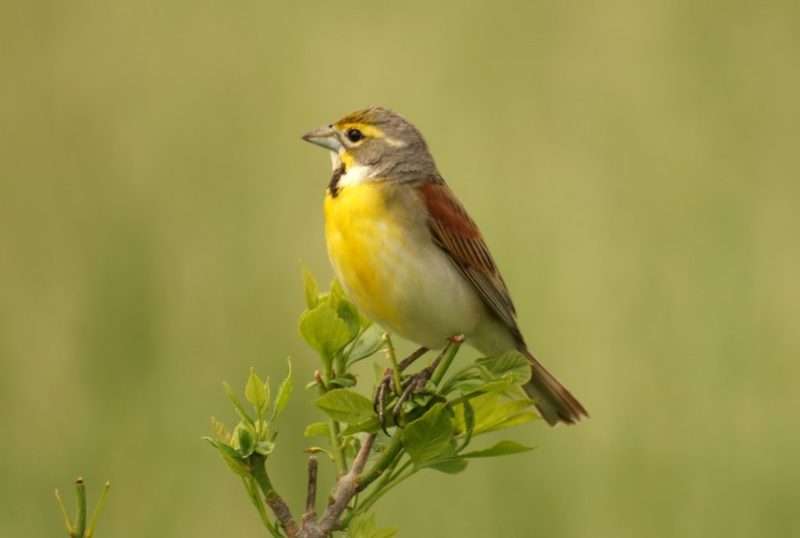
The Dickcissel (Spiza americana) is a grassland songbird that shares some resemblance with house sparrows but is distinguished by its bright yellow breast and bold black bib in males. Females and immature birds are browner overall with less vivid coloration, but still show hints of yellow and a facial pattern with a light eyebrow. These birds typically measure between 5.5 to 6.3 inches in length and have a chunky, seed-eating beak.
Dickcissels are most often found in Iowa during the breeding season, particularly from late spring through summer. They favor open country, prairies, hayfields, and grassy pastures, often perching on fence posts or the tops of tall grasses to sing their buzzy “dick-dick-cissel” song. These perches give them a good vantage point to survey their territory and attract mates.
Their behavior is similar to that of meadowlarks, though they are smaller. Males are highly territorial and will often sing for long periods during the day. Dickcissels feed on a variety of seeds and insects, which they glean from grasses or pick directly from the ground. During the nesting season, they build cup-shaped nests close to the ground in thick grasses or low shrubs.
Although their numbers can fluctuate dramatically from year to year, Dickcissels are a common sight in southern and central Iowa grasslands. Conservation of open prairie and agricultural field edges is crucial for maintaining their populations, as they are dependent on these increasingly rare habitats for breeding success.
Western Meadowlark
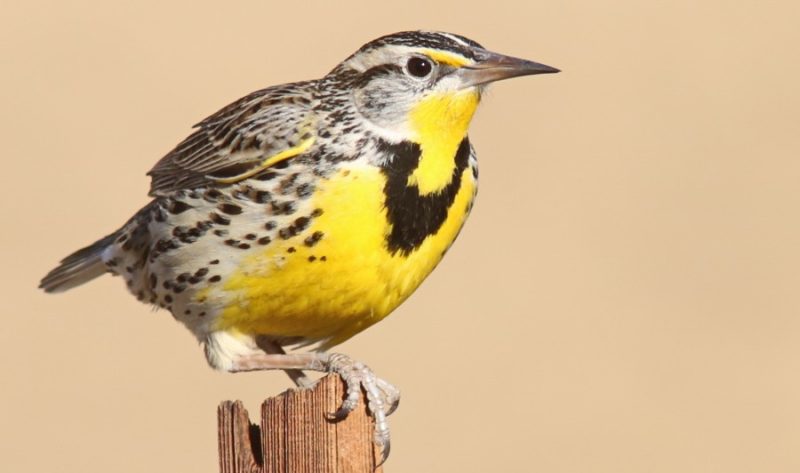
The Western Meadowlark (Sturnella neglecta) is a striking and melodic bird that brightens Iowa’s open fields with both its vivid coloring and flute-like song. Adult meadowlarks are medium-sized, measuring about 6.3 to 10.2 inches long, with a wingspan ranging from 16.1 to 16.5 inches. Their most distinctive feature is the bright yellow underparts marked with a bold, black “V” across the chest. The upperparts are mottled brown and black, providing camouflage in grassy habitats. Though similar to the Eastern Meadowlark, the Western species is typically identified by its song and subtle differences in facial markings.
Western Meadowlarks are ground-foraging birds that primarily feed on insects such as beetles, grasshoppers, and caterpillars during the warmer months. In fall and winter, their diet shifts more toward seeds and grains. They walk or hop slowly through the grass, probing the soil and vegetation for food. These birds are often seen standing on fence posts or tufts of grass, surveying the land or singing to declare territory and attract mates.
In Iowa, Western Meadowlarks are more commonly found in the western and central regions, where native grasslands, pastures, and hayfields are abundant. Their preferred habitats include open prairies and cultivated farmlands with minimal tree cover. Though once more widespread, habitat loss and conversion of native prairie to agriculture have made suitable areas more fragmented, especially in the eastern parts of the state.
Their song is one of the most beloved sounds of the prairie—clear, descending whistles that are both beautiful and unmistakable. During breeding season, they nest in grass-lined depressions on the ground, often covered with a dome of woven grasses. Their cryptic plumage makes them well-camouflaged in the grassy landscape, and they rely on stealth and stillness to avoid predators.
Pine Siskin
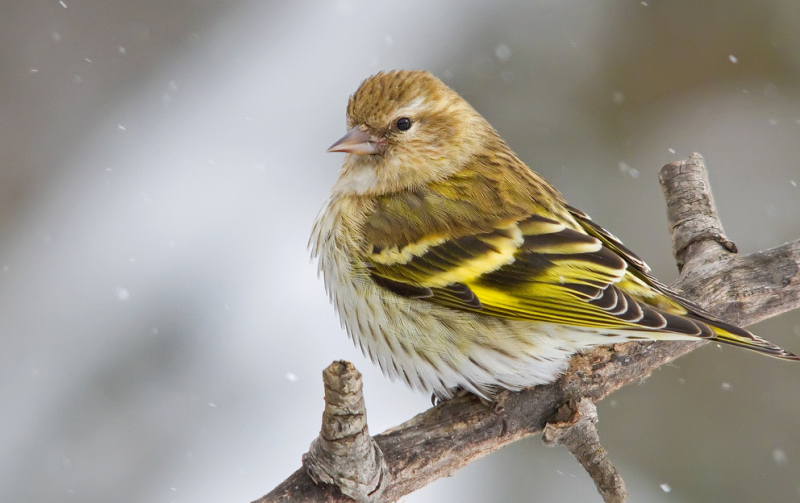
The Pine Siskin (Spinus pinus) is a small, streaky finch with subtle yet beautiful yellow highlights that can be seen flashing in flight. Measuring just 4.3 to 5.5 inches long with a wingspan of around 7.1 to 8.7 inches, Pine Siskins are often overlooked until they arrive in flocks and begin feeding actively at backyard feeders or in weedy fields. Their overall plumage is brown and heavily streaked with darker lines, and yellow patches on the wings and tail become especially noticeable when they flutter or take off.
Though they resemble female House Finches at first glance, Pine Siskins are smaller, more slender, and have a thinner, pointed bill. Their call notes are also helpful for identification: a rising “zzzzzreeeee” sound and sharp, buzzy trills that are quite different from other finches. These vocalizations are often heard before the birds are seen, especially when they arrive in active, swirling groups.
Pine Siskins are irregular visitors to Iowa, particularly in the winter months when they move south from northern forests in search of food. Their numbers vary dramatically from year to year, depending on cone crop failures in the boreal forest. When food is scarce farther north, large numbers may appear in Iowa, especially in parks, coniferous areas, and neighborhoods with well-stocked feeders.
They feed on a variety of small seeds, including those from alder, birch, spruce, and pine, as well as thistle and sunflower seeds at feeders. Their small size and acrobatic feeding behavior allow them to hang upside down while extracting seeds, which adds to their charm. During irruption years, they may also stay to breed in northern Iowa, especially in conifer stands, though nesting there is relatively rare.
Tips for Spotting & Identification of Yellow Birds in Iowa
Identifying yellow birds in Iowa can be an exciting and rewarding experience for birdwatchers of all levels. With a mix of grasslands, wetlands, woodlands, and suburban habitats, Iowa is home to many yellow-hued species, especially during spring and summer migration. While bright plumage helps many of these birds stand out, some require close attention to subtle markings, songs, and behavior. Understanding key identification tips can make all the difference when spotting these cheerful birds in the field.
Coloration and Seasonal Changes are among the first things to observe. Many yellow birds, like the American Goldfinch, undergo noticeable seasonal molts. Males display vibrant yellow in summer but become drab olive-brown in winter, sometimes confusing novice birders. Similarly, warblers like the Yellow Warbler remain mostly yellow year-round, while other species such as the Pine Siskin may only flash yellow in their wings or tail during flight. Lighting also affects how bright yellow plumage appears, so observing the bird in both sunlight and shade can provide a clearer sense of color.
Size, Shape, and Behavior are vital tools in the identification process. For instance, the Dickcissel has a chunkier, finch-like build with a thicker bill, while warblers such as the Common Yellowthroat are smaller, sleek, and more active in low vegetation. The Western Meadowlark is notably larger, with a thicker body and a striking black “V” across its chest. Flight patterns can also be helpful: the American Goldfinch has a distinctive, bouncy, undulating flight, often accompanied by its “po-ta-to-chip” call, while Yellow Warblers flutter and hover through thickets searching for insects.
Listening for Vocalizations is one of the most effective methods for locating yellow birds in Iowa. Each species has a unique song or call that can help pinpoint its location, even before it’s seen. The Common Yellowthroat’s “wichity-wichity-wichity” song is loud and repetitive, often coming from dense marsh vegetation. The Western Meadowlark is best known for its melodic, flute-like song that carries across open fields. Recognizing these vocal patterns not only aids in identification but also reveals habitat preferences and seasonal presence.
Know the Habitat to narrow down your search. Iowa’s yellow birds are often habitat-specific. American Goldfinches favor weedy fields, gardens, and feeders, while Yellow Warblers are common in willows and shrubs near water. Dickcissels prefer prairie grasslands and agricultural edges, and Common Yellowthroats stick to thick, moist vegetation like marshes and overgrown ditches. In winter, Pine Siskins may visit feeders or forage in coniferous stands and mixed woodlands. Observing the environment closely can guide you to the right species and increase your chances of a successful sighting.
By combining visual cues with vocal recognition and habitat awareness, birders can become adept at identifying the many yellow birds that brighten Iowa’s landscapes. Patience, practice, and a good pair of binoculars can turn every outing into a rewarding birdwatching experience.
Frequently Asked Questions About Yellow Birds in Iowa
What is the most common yellow bird in Iowa?
The most common yellow bird in Iowa is the American Goldfinch. It is also the state bird of Iowa. Males are bright lemon-yellow during the summer with a black cap and wings, while females are duller in color. They are seen year-round in Iowa and are frequent visitors to backyard feeders, especially those stocked with sunflower or thistle seeds.
When can I see yellow birds in Iowa?
Yellow birds can be seen in Iowa throughout the year, but spring and summer offer the highest variety. Migratory species, such as Yellow Warblers and Common Yellowthroats, typically arrive in late April and remain through summer. Year-round residents like American Goldfinches may change color in winter but remain present in the state.
Where should I look for yellow birds in Iowa?
The best places to look for yellow birds in Iowa include open fields, wetlands, shrublands, prairies, and backyards with feeders. For example, Common Yellowthroats prefer dense marshy vegetation, while Dickcissels and Western Meadowlarks are more likely found in grasslands and agricultural areas. Yellow Warblers favor willow thickets near water.
Do yellow birds visit feeders in Iowa?
Yes, several yellow birds visit feeders. The American Goldfinch is the most common yellow feeder bird and loves nyjer (thistle) and sunflower seeds. Pine Siskins, when present, also visit feeders, especially during irruption years. Warblers and meadowlarks are less likely to visit feeders, as they primarily forage for insects and seeds in natural habitats.
How can I tell the difference between a Yellow Warbler and a Common Yellowthroat?
Though both are small yellow birds, they differ in key features:
-
The Yellow Warbler is bright yellow all over with faint reddish streaks on the breast (in males) and no facial mask.
-
The Common Yellowthroat has a black mask across the eyes (in males) and an olive back with a bright yellow throat and chest.
Are there any large yellow birds in Iowa?
While most yellow birds in Iowa are small songbirds, the Western Meadowlark is relatively larger, measuring 8–11 inches in length. It has a bright yellow belly with a bold black “V” on the chest and is commonly found in prairies and pastures.
Why do some yellow birds look dull in winter?
Many yellow birds, especially the American Goldfinch, undergo a seasonal molt, where their feathers change color. In winter, male goldfinches lose their bright yellow plumage and become a muted olive or brown color. This helps them blend into the environment and conserve energy in colder months.
Do all yellow birds migrate out of Iowa in winter?
Not all of them. The American Goldfinch and Pine Siskin are often present during the winter, although Pine Siskins vary year to year depending on food availability. Yellow Warblers, Common Yellowthroats, and Dickcissels are migratory and typically leave Iowa in the fall to winter in Central or South America.

